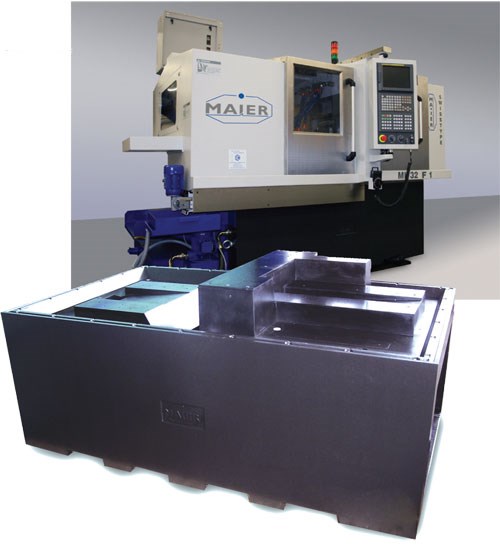Concrete Reasoning On Swiss Turning
This tech brief discusses the application of polymer concrete as a machine base material for precision Swiss turning.
High-precision machining begins with a solid machine tool base. Its critical functions are to provide a thermally stable platform for the moving components mounted on it and to provide damping for the cutting forces channeled into it.
For many years, cast iron or steel weldments have been the materials of choice for most machine tool bases. But as tolerances become tighter, workpieces more delicate/complex and metals more exotic, machine tool builders are looking for better ways to build in capability for increased accuracies, better surface finish quality, deeper cuts and faster cycle times. In response, machine builder Maier has incorporated polymer concrete as the base material for its line of CNC Swiss-type machines.
It’s not a huge leap to consider polymer concrete as a machine base material. After all, the most precise machine tools—grinders—have used the material for years. Most CMMs use solid granite as a base material for measuring metalworking’s most precise parts. Accuracies of as much as 0.0001 inch (0.00254 mm) can be consistently held on machines with polymer concrete bases. So if you are trying to up the precision ante for Swiss-type machining, the machine base may be the best place to start.
On Performing–Solid Results
Polymer concrete is dense, rigid, dimensionally and thermally stable, resistant to water and chemicals and will not twist or bend when stress is introduced. Most of all, it has superb vibration dampening qualities.
For machines that offer high speeds, high acceleration rates, fast positioning cycles and multiple tool changes, the number of rapid movements is increased and so is the need for the machine base to absorb the movements. For example, measurements have proven that polymer concrete diminishes vibrations eight to ten times faster than gray cast iron. Obviously the more the vibrations are absorbed, the easier it is to make faster, deeper cuts while maintaining maximum accuracy and longer tool life.
By employing polymer concrete, a more thermally stable, sturdier machine bed can be built. The polymer concrete material offers a high-heat capacity combined with low-heat conductivity, allowing the base sufficient time to react to temperature influences and fluctuations because of outside heat factors and internal heat sources including pumps, engines, guidance and spindles. This minimizes deformations that might be caused by temperature changes and provides high machining accuracy.
The material can also be formed very flat, with a smooth, mirror-like finish, all of which helps ensure accurate positioning of machine-to-base when compared to joined cast iron or steel weldments. Moreover, because the casting process is relatively cold, electric conduit and hydraulic lines can be cast in the base.
Machine bases are often measured according to rigidity statistics. Polymer concrete can be classified as an isotropic, homogeneous material that has a higher rigidity than cast iron material. Since the polymer concrete base is so dense and its sections are massive, it weighs considerably more than a typical cast base. In this case, increased mass is beneficial for a sturdier base, which in turn, improves vibration dampening.
Unlike conventional metals, a polymer concrete machine base will not rust, making it an effective choice when coolants/liquids are used during the machining process. This eliminates the need for corrosion protection measures and reduces the number of metallic part failures (for example, guideways, contact surfaces). In addition, polymer concrete does not absorb water, so moisture expansion is avoided.
Polymer concrete also provides low combustibility and flammability because it is composed of 93 percent non-combustible materials. The material is environmentally friendly, and significantly less energy and power consumption is required to manufacture a machine base.
When all the material characteristics and performance data are considered, it makes sense to have a polymer concrete base under a lathe. The odds are the industry will be seeing more of this material applied to other machine tools in the future.
Related Content
Getting More Production From Swiss Turning Centers
Buying a new CNC Swiss turning center is a substantial investment. For the best return, look closely for capabilities that enable the best utilization of the machine.
Read MoreKeeping Watch on Small Parts
From watch parts to exotic medical applications, this shop takes on the world of micromachining.
Read MoreWhen a CNC Turn-Mill Doesn’t Turn
A shop in Big Sky Country uses a B-axis multitasking machine to produce complex, prismatic medical parts that require no turning complete from barstock.
Read More5-Axis Machining Centers Transform Medical Swiss Shop
Traditionally a Swiss machine shop, Swiss Precision Machining Inc. discovers a five-axis machining center that has led the company to substantial growth. (Includes video.)
Read MoreRead Next
Do You Have Single Points of Failure?
Plans need to be in place before a catastrophic event occurs.
Read MoreSeeing Automated Workpiece Measurement in Real Time
User-friendly inspection software for CNC machining centers was shown at IMTS 2024 monitoring measurements between and after machining while performing SPC based on recorded measurement values.
Read More5 Aspects of PMTS I Appreciate
The three-day edition of the 2025 Precision Machining Technology Show kicks off at the start of April. I’ll be there, and here are some reasons why.
Read More
















.jpg;maxWidth=300;quality=90)







